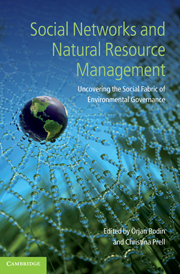 Social Networks and Natural Resource Management
Social Networks and Natural Resource Management Book contents
- Frontmatter
- Contents
- Contributors
- Foreword
- Part I Introduction
- Part II Case studies
- 4 Barriers and opportunities in transforming to sustainable governance: the role of key individuals
- 5 Social network analysis for stakeholder selection and the links to social learning and adaptive co-management
- 6 Who and how: engaging well-connected fishers in social networks to improve fisheries management and conservation
- 7 The effects of social network ties on the public’s satisfaction with forest management in British Columbia, Canada
- 8 Social network models for natural resource use and extraction
- 9 Friends or neighbors? Subgroup heterogeneity and the importance of bonding and bridging ties in natural resource governance
- 10 The role of individual attributes in the practice of information sharing among fishers from Loreto, BCS, Mexico
- 11 Transformative collective action: a network approach to transformative change in ecosystem-based management
- 12 Social networks, joint image building, and adaptability: the case of local fishery management
- 13 Agrarian communication networks: consequences for agroforestry
- Part III Summary and outlook
- Index
- References
9 - Friends or neighbors? Subgroup heterogeneity and the importance of bonding and bridging ties in natural resource governance
from Part II - Case studies
Published online by Cambridge University Press: 05 June 2012
- Frontmatter
- Contents
- Contributors
- Foreword
- Part I Introduction
- Part II Case studies
- 4 Barriers and opportunities in transforming to sustainable governance: the role of key individuals
- 5 Social network analysis for stakeholder selection and the links to social learning and adaptive co-management
- 6 Who and how: engaging well-connected fishers in social networks to improve fisheries management and conservation
- 7 The effects of social network ties on the public’s satisfaction with forest management in British Columbia, Canada
- 8 Social network models for natural resource use and extraction
- 9 Friends or neighbors? Subgroup heterogeneity and the importance of bonding and bridging ties in natural resource governance
- 10 The role of individual attributes in the practice of information sharing among fishers from Loreto, BCS, Mexico
- 11 Transformative collective action: a network approach to transformative change in ecosystem-based management
- 12 Social networks, joint image building, and adaptability: the case of local fishery management
- 13 Agrarian communication networks: consequences for agroforestry
- Part III Summary and outlook
- Index
- References
Summary
Introduction
“The more you know, the less you understand” is a well-known proverb that in some ways aptly depicts our relationship with the natural environment around us. This does not mean that science and our understanding of nature has not advanced over time – it has. But with increasing knowledge we have also come to realize that the complexity of natural systems is far greater than imagined and that this complexity causes ecosystems to continuously change in non-linear and sometimes unpredictable ways (Carpenter et al., 2001; Scheffer et al., 2001; Folke et al., 2004). To be able to deal with such uncertainty requires management approaches which can also learn and adapt to changing conditions over time. Adaptive co-management, outlined in more detail in Chapter 3, is one approach which has been championed as a way to deal with uncertainty and surprise in natural resource management. This concept has two key defining characteristics; learning and collaboration. Learning is seen as a key to remaining adaptive. Collaboration, more specifically the involvement of local stakeholders in the governance process, is assumed to provide legitimacy for governance action and management decisions, but it is also a potential source of diversity of perspectives and knowledge which can contribute to increased learning and improved management decisions (e.g. Armitage et al., 2008). However, for adaptive co-management to work, (self-) organization of stakeholders and collective action have also been suggested as vitally important (Olsson et al., 2004), and this in turn is influenced by the ability of the involved parties to agree on resource-related problems and resource status (Ostrom, 2005 and references therein). In this chapter we are particularly concerned with how the ability of a community to learn and adapt, and to collectively respond to common resource problems, can be affected by the structure of the social networks within it. Furthermore, we explore to what degree the existence of cohesive subgroups, and their composition in terms of actors’ attributes in the form of occupation and tribal ethnicity, can help to explain why a community experiencing significant decline in marine resources over a number of years has not come together to alter unsustainable practices.
- Type
- Chapter
- Information
- Social Networks and Natural Resource ManagementUncovering the Social Fabric of Environmental Governance, pp. 206 - 233Publisher: Cambridge University PressPrint publication year: 2011
References
- 9
- Cited by


